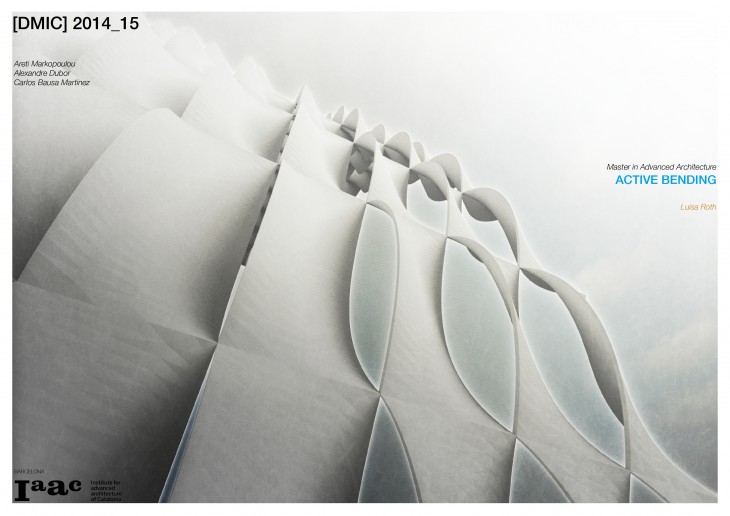Group: Arnellou Zoi-Dafni, Papakonstantinou Eirini-Aikaterini, Sarantinoudi Panagiota
Objective: Design a structural and self-assembling structure from a two-dimensional, flexible material like fabric
Group: Arnellou Zoi-Dafni, Papakonstantinou Eirini-Aikaterini, Sarantinoudi Panagiota
Objective: Design a structural and self-assembling structure from a two-dimensional, flexible material like fabric
The material research is focused on bending behavior and bending actuation to design a system which can react on environmental influences such as humidity.
The research is based on active bending behavior which can be found in organic materials as for instance wood. The deformation of wood is affected by several factors such as grain direction and material expansion. The objective is to focus on the expansion of different materials to trigger bending deformations.
As yet I concentrated on controlling the deformity of materials by controlling the expansion of an active material. The aim is to create a material system activated by water which reuses the absorbed water for cooling. The focus is to design some kind of a breathing system that can react on environmental factors to improve the air conditions inside a building.

Read More
The design research was focused on inflation and its effect on material behavior. Working with air inflation as an external stimuli, several materials were tested and filtered (silicone, liquid rubber, latex…).
Silicone is the main component which could act as a soft inner structure or could be coated on other material layers.Throughout the initial phase of the research, we studied different movement behaviors (bending, expansion, curling…) of pneumatic silicone molds with inner pattern of air gaps. Then, we based our interest to explore how inflation could reveal textures on a composite layer material system and how would that lead to specific architectural applications. Our objective is to create a pneumatic system that would respond to external forces like wind and act in the same time as a soft envelope that would create a micro climate surrounding the building space.
Material tests were done on soft layers of silicone composites that would be bumbed when inflated due to different material expansion properties. These dimples could be part of an envelope plugged on high rise towers and reduce wind drags.
Students: Devika Chandrababu, Fathimath Sujna Shakir, Ninada Kasyap
Objective:Exploring the potential application of Ferrofluid in architecture.
Description: Ferrofluid is a stable colloidal suspension of sub-domain magnetic particles in a liquid carrier. It becomes strongly magnetized in the presence of a magnetic field. Our objective is to study the various properties and behavior of ferrofluids. Various experiments were carried out to study the behavior of the fluid in different magnetic fields, including the patterns formed. We concentrated on the fluidity of the ferrofluid and tried to manipulate that property to arrive at a potential architectural application. Other tests were conducted to find a suitable solution to suspend the ferrofluid in, which was clear, non conducting and non magnetic, and which prevented staining of the walls on the container by the ferrofluid.
Team : Anusha Arun | Kunaljit Singh Chadha | Yessica Mendez
Intent : Working with nanoscale particles to change the original behaviour of a material.
Preface : The Hydrophobic effect observed is a tendency of non-polar substances to aggregate aqueous solutions and exclude water molecules.The word Hydrophobic literally means ‘water fearing’, and it describes the segregation and aparent repulsion between water and non polar substances.In chemistry , water is considered to be the universal solvent , and materials that are Hydrophilic dissolve in it.However, Hydrophobic molecules do not dissolve in water.The aim is to control the deformity of the hydrophilic materials with addition of hydrophibic component which then are responsive to natural stimuli.